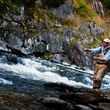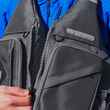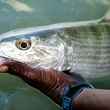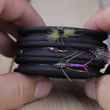High-sticking, Euro-nymphing, contact nymphing, tight-line nymphing, Czech nymphing, in-line nymphing, mono-rig nymphing, polish nymphing, and so on. It is possible that there has never been so many different ways to describe what is, generally, a single method of fishing. For our purposes here, less settle on Euro-nymphing which, much like flat brimmed hats and leather bracelets, has taken the fly-fishing community by storm over the past few years. It’s by far the fastest growing segment of our sport and with good reason—as anyone who pays attention to some of the numbers of fish caught by competition anglers that use the technique will tell you.
Euro-nymphing involves being in direct contact with your nymph (or, more commonly, nymphs) as they bounce along the bottom while using a sighter line—bright colored mono that allows you to eliminate the use of a traditional “suspension type” indicator, aka the “bobber.” Euro-nymphers typically employ long, ten to eleven-foot wisps of rods—3, 2, 1 and even 0 weights. Although possible with your father’s nine-foot 5 weight rod, longer rods with softer tips allow for better reach, drift control and the ability to “feel” the nymphs bouncing along the bottom.
Until recently, we’d seen a proliferation of rods specifically designed for this technique but never a reel specific to the task.
Enter the new Sage ESN reel. This is the first reel specifically designed for contact nymphing applications and one that features a design that seems destined to send a countless number of Euro-nymphing aficionados (and maybe a few reel manufacturers) into a why-didn’t-I-think-of-that tizzy.
What Works
Appearance
The Sage ESN reel is built from machined T6061 bar stock aluminum and is offered in one size (2-5 weight) and two colors: stealth black and chipotle. Both are striking good looking reels, but if you prefer maximum stealth on the river, then black is the way to go.
Closed Frame
The ESN reel is designed with an ultra-thin, closed frame which eliminates every contact nymph fisherman’s recurring nightmare—having the mono line or leader slipping under and through the frame and getting wrapped around the drag in the guts of the reel. Given the closed frame and the tight tolerances to which the ESN reel is manufactured, Sage may have eliminated this frequent frustration altogether.
The Balance Point
This is where the ESN reel shines. It comes with three counterweights, 1/2, 1 and 1 ½ ounces, which are used to adjust the overall weight of the reel. The weights are machined with an “octagonal” attachment fixture which allows you to “index” the balance point of your rod by shifting the weight towards the top or bottom of the reel. Overall, it’s a system that effectively gives you 24 possible options for distributing the weight of your reel.
The internal mechanism for placing the weight is simple to use, simply remove the spool and unscrew the lock nut ring. Choose the desired weight, screw the lock nut ring back on and replace the frame. Check your balance point and repeat the process to really dial in the balance of your setup.

The balance point of the reel, for those that may be confused by this should be towards the top of your grip. This is important because longer rods mean more weight. More weight means more arm fatigue. More fatigue translates to you eventually dropping your arm. Dropping your arm prevents a successful drift. And thus, the need to balance out the longer rod-and-reel setups common in the world of contact nymphing becomes paramount.
Until now, the norm has been to balance out the butt section of the longer rods with oversized reels, transitioning the weight from the mid and tip sections of the rod towards the butt section of the rod in the hopes of landing the balance point near the rod grip. Now, with the new ESN reel, not only has Sage taken the guesswork out of balancing your Euro-nymphing setup, but you’ll be able to pull it off without a reel that looks like it’d be more at home on a tarpon skiff.
It’s also worth noting that the weights come packaged in their own, adorable little neoprene case which makes storage of the spares easy and tidy.
The Guts
A fully enclosed SCS (sealed carbon drag system) has been a fixture on Sage’s reels for quite a while and Sage’s drag package is time tested and proven. While we can all certainly agree that the stopping power of Sage’s carbon drag system won’t often be put to the test on most trout streams, that doesn’t mean that its startup inertia won’t. Sage’s SCS system offers a silky-smooth startup which is paramount for protecting the ultra-light tippets commonly used by Euro-nymphers (think of the 7 thru 10x often used by competition anglers).
Still, on a recent outing where the game was supposed to be exclusively fishing for ten-inch trout—I stumbled into a surprise 5 lb. carp that had no business being in an obvious trout lie, or even in that creek, for that matter. The old boy ran downstream about thirty yards in current and put the drag, my 3-weight rod and my 6X tippet to the test. After the worst ten minutes of my life, the fish came to the net and, let me tell you, the drag works just fine.
Sage’s signature, numbered, one-revolution drag knob also deserves mention — making adjustments easy and foolproof.
Large Arbor
One of the other things you’ll first notice about the reel is its compact, narrow frame and ultra large arbor—which makes picking up line fast a cinch. Although you could use a conventional fly line on the reel, it is certainly designed for thinner diameter comp lines. Capacity runs around 75 yards of 20lb backing with your standard RIO FIPS comp line on it. I know some people obsess over having at least 100 yards of backing on their reels but, really, honestly, was the last time you needed that much backing on a trout?
What Doesn’t
Cost
Coming in at $425, the reel is certainly not cheap. But for all the specialty bells and whistles you’re getting with the ESN reel, it’s one of the few freshwater trout reels that I can comfortably justify spending over $350 for—if for no other reason than the fact that it has design features that offer real-world fishing advantages which you can’t find anywhere else.
Slap Retrieve
Full frame reels, by virtue of their design, do tend to restrict a slap retrieve. Traditionally, I tend to pick up line this way the vast majority of the time, especially if a fish is running towards me or if I want to bring in a pile of line and shorten up my cast. But there are always prices to be paid, compromises to make, when designing a piece of fishing gear. In the case of the ESN reel, the disadvantages of not being able to use a slap retrieve are far outweighed by the advantages of not having to regularly dismantle your reel and dig your rig out of the guts of your drag. And, it’s worth mentioning, the aforementioned large arbor goes a long way towards providing an almost-as-fast option for line pickup. In other words, I’m probably stretching on this gripe, but it bears mentioning nonetheless.
Final Word
The Sage ESN reel is a stunner. While chatting with another Euro-nymph angler recently, we both agreed that we couldn’t fathom why, given the glut of Euro rods on the market today, no reel geared towards this niche market had previously been introduced.
Other reel manufacturers are going to be playing catchup with Sage on this one. With its ESN reel, Sage hit the mark first—and hit it right on the bullseye.































Comments
Joseph Pratt replied on Permalink
What is a “slap retrieve”? In all my reading on fly fishing this is the first time I’ve seen this term.
Chad Shmukler replied on Permalink
Retrieving line back onto the spool of your reel by "slapping" the spool with a downward hand motion so that it spins on the reel frame (as opposed to grabbing the reel handle and manually rotating the spool).
In situations where you need to get your line back onto the spool as fast as possible (commonly referred to as "clearing" line)—like when a bonefish or permit takes off and line off the spool is prone to tangling and thus breaking off the fish—this method can be much, much faster than retrieving line with the spool handle.
For the vast majority of trout fishing, this isn't a worry. But it becomes a habit for many anglers and their preferred/reflexive way of picking up line.
And, of course, as noted in the review, full frame reel prevents this (as you can't slap the spool in the same way). But, given the benefits for Euro-nymphers, the inability to use a retrieve method that isn't really needed in the world of trout fishing is a minor tradeoff for all the benefits introduced.
Jan Light replied on Permalink
I did have an initial complaint about this reel. I found that the heavily knurled and protruding hub knob meant that my hand found this rather than the crank handle. But recently I realized that I can use it to quickly retrieve line by giving it a spin. I haven't seen anything that suggests that this was Sage's intention, but it sure works - possibly better than a slap retrieve.
Magnus replied on Permalink
Industry first? What about the Vision XLV Nymph?
https://visionflyfishing.com/product/xlv-custom/
Pages